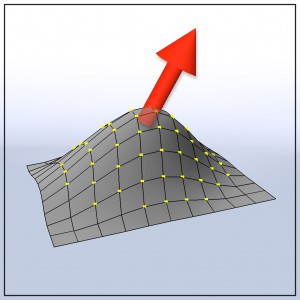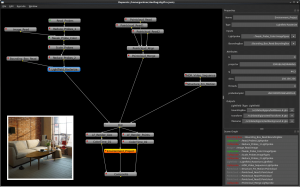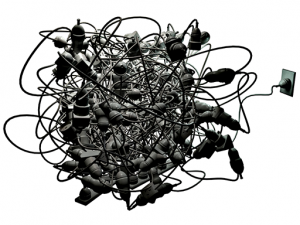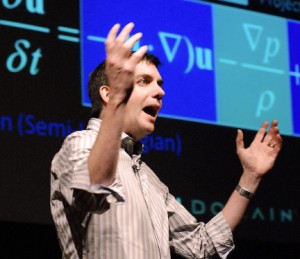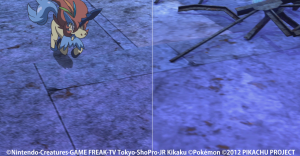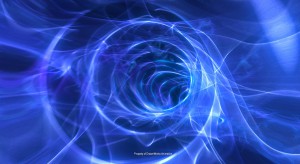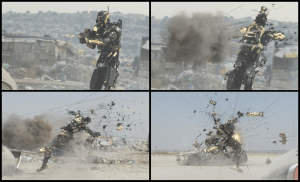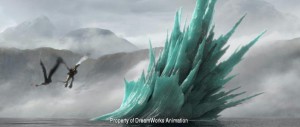Introduction
Doug Epps & Phil Peterson, Symposium Co-Chairs
Nafees Bin Zafar & Larry Gritz, Program Co-Chairs
Session: Squash, Stretch & Render
Modeling Tools at Disney Animation
Dmitriy Pinskiy, Jose Luis Gomez Diaz
Walt Disney Animation Studios
In this presentation, we overview the major custom modeling tools developed at Walt Disney Animation Studious. In our tools we place emphasis on three main aspects – being intuitive for modelers, interactivity, and seamless integration into Maya workflow. These tools include (1) Dragnet – a suite of brushes to sculpt or cleanup the geometry, (2) dPatch – a tool to generate light-weight quad meshes from hi-res zBrush models, and (3) Retopology – a tool to create quad meshes with controlled vertex/face count and user-driven edge flow from cloth garment models generated in Marvelous Designer.
Delta Mush: Smoothing Deformations While Preserving Detail
Joe Mancewicz, Matt L. Derksen, Hans Rijpkema, Cyrus A. Wilson
Rhythm & Hues Studios
Delta Mush is a Voodoo deformer that smooths arbitrary deformations applied to a polygonal mesh, without smoothing the original detail of the model. Since 2010, it has been used in all character rigs at Rhythm & Hues, simplifying rigging workflows while simultaneously improving rig performance during animation.
Computer graphics and particle transport: our common heritage, recent cross-field parallels and the future of our rendering equation
Eugene D’Eon
8i
In this personal viewpoint talk I will discuss the inspiration, motivation, impact and potential future of a five-year effort to seek out and understand transport theory results from other fields and find application for them in computer graphics. Topics include modified diffusion theory, rigorous benchmarks, and non-classical transport theory with non-exponential free path distributions.
Session: Pipe Dreams
Houdini Engine: Evolution Towards a Procedural Pipeline
Ken Xu, Damian Campeanu
Side Effects Software, Inc.
Proceduralism has become increasingly important to both film and game pipelines. By utilizing procedural approaches, production teams in both film and games can significantly reduce timelines and enhance flexibility. In recent years, due to the increasing demand on gaming pipelines to provide ever increasing amounts of content, and the need to retain revisability of content late into the production cycle, procedural approaches have been gaining traction in gaming pipelines as well. However, Houdini’s core technology remained inside of Houdini the application, whose workflows and interfaces weren’t familiar to many artists.
This paper details the evolution of the Houdini Engine project, where we focus on the many technical decisions and challenges that we had to face along the way, detailing some of the reasoning and tradeoffs behind our software design choices.
Depends: Workflow Management Software for Visual Effects Production
Andrew Gardner, Jonas Unger
Linköping University, Sweden
We present an open source, multi-platform, workflow management application named Depends, designed to clarify and enhance the workflow of artists in a visual effects environment. By providing an interface to organize nearly any command-line application into a directed acyclic dependency graph, Depends is as flexible as it is extensible, and can easily fit into many existing pipelines.
Can We Solve the Pipeline Problem?
Cristian S. Calude, Alasdair Coull, J.P. Lewis
University of Auckland / Weta Digital / Victoria University, NZ
A list of the most important unsolved problems in VFX production should include the word “pipeline”. Pipelines are a major source of efficiency, but they require ongoing development, and it seems they are never done. They also resist change. We draw comparsions between pipelines and programs, and recall metamathematical statements that programming cannot be fully automated. We are
left with the conclusion that pipelines are not something that can be “solved”.
CG Pipeline Design Patterns
Bill Polson
Pixar Animation Studios
The field of CG Pipelines is ready for some analysis. One way to approach this is via the “Design Patterns” approach:
- descriptive rather than prescriptive
- identify things “we all seem to know and do”
- give them names, and
- look for common themes and relationships.
This talk discusses this approach, and offers some preliminary results. As an example I’ll use Design Patterns to describe the evolution of the modeling pipeline at Pixar over a period of 10 years.
Keynote
Doug Roble
Creative Director of Software at Digital Domain
Software development for visual effects is, like always, facing challenges. Shrinking budgets, difficult problems and the pull of non-film jobs has made producing innovative software for films trick. The Academy of Motion Picture Arts and Sciences has always tried to recognize new inventions that change the way movies are created. After more than a decade on the Sci/Tech Awards committee, Doug will delve into the details of the awards process. The awards are a very important part of the film community, but many don’t know how they work and what the Academy is looking for. Hopefully, this talk will throw some light on what is perceived as a mysterious process.
Session: Effects Poutine
The Brush Shader: A Step towards Hand-Painted Style Background in CG
Marc Salvati, Ernesto Ruiz Velasco, Katsumi Takao
OLM Digital, Inc.
We will detail how we reproduced hand-painted texture and background by simulating Photoshop functionalities in a shader: the Brush Shader. This results in much detailed shading, and releases us from restrictions on camera work related to matte painting imperatives.
Time Travel Effects Pipeline in “Mr. Peabody & Sherman”
Robert Chen, Fangwei Lee, David Lipton
DreamWorks Animation
In DreamWorks Animation’s Mr. Peabody & Sherman, our titular duo travel back in time through magical wormholes. We needed a system that creates intricate and ethereal wormhole tunnels, which were inspired by the mathematical fractal flame images. Yet, unlike fractal systems, it needs to be highly art-directable and animated so the tunnels can materialize, disintegrate, and branch off as the time machine travels through them. The system also needs to be scalable in order to create lots of tunnels in wide shots while maintaining details in close-up shots. Due to the scale of the effect and its use across multiple shots throughout the show, we’ve set up a pipeline for the Layout, Animation, Effects, and Lighting departments to collaborate on. The pipeline is divided into several stages, and as artists advance through these stages, the look gets more refined: from the broad strokes to the finest details.
Choreographed droid destruction on Elysium
Greg Massie, Koen Vroeijenstin
Image Engine
For a key sequence in Neill Blomkamp’s Elysium, we needed to destroy a droid in extreme slow motion. In this talk we describe our procedurally motivated approach to choreographed destruction, which provided the flexibility and visual quality to match precise artistic direction, while enabling fast inter-departmental turnaround.
Arctic Ice: Developing the Ice Look for How to Train Your Dragon 2
Feng Xie, Mike Necci, Jon Lanz, Paolo deGuzman, Patrick O’Brien, Eduardo Bustillo
DreamWorks Animation
We present the technical and creative solutions developed to achieve the artistic vision for ice in How to Train Your Dragon 2, where ice played a dominant role from the arctic North, to the Dragons’ ice mountain home and to the powerful Dragon king’s icy breath.
Discussion
An open discussion for all attendees on this year’s symposium and planning for DigiPro 2015.
Reception
Enjoy a beverage and conversation with your fellow attendees!

